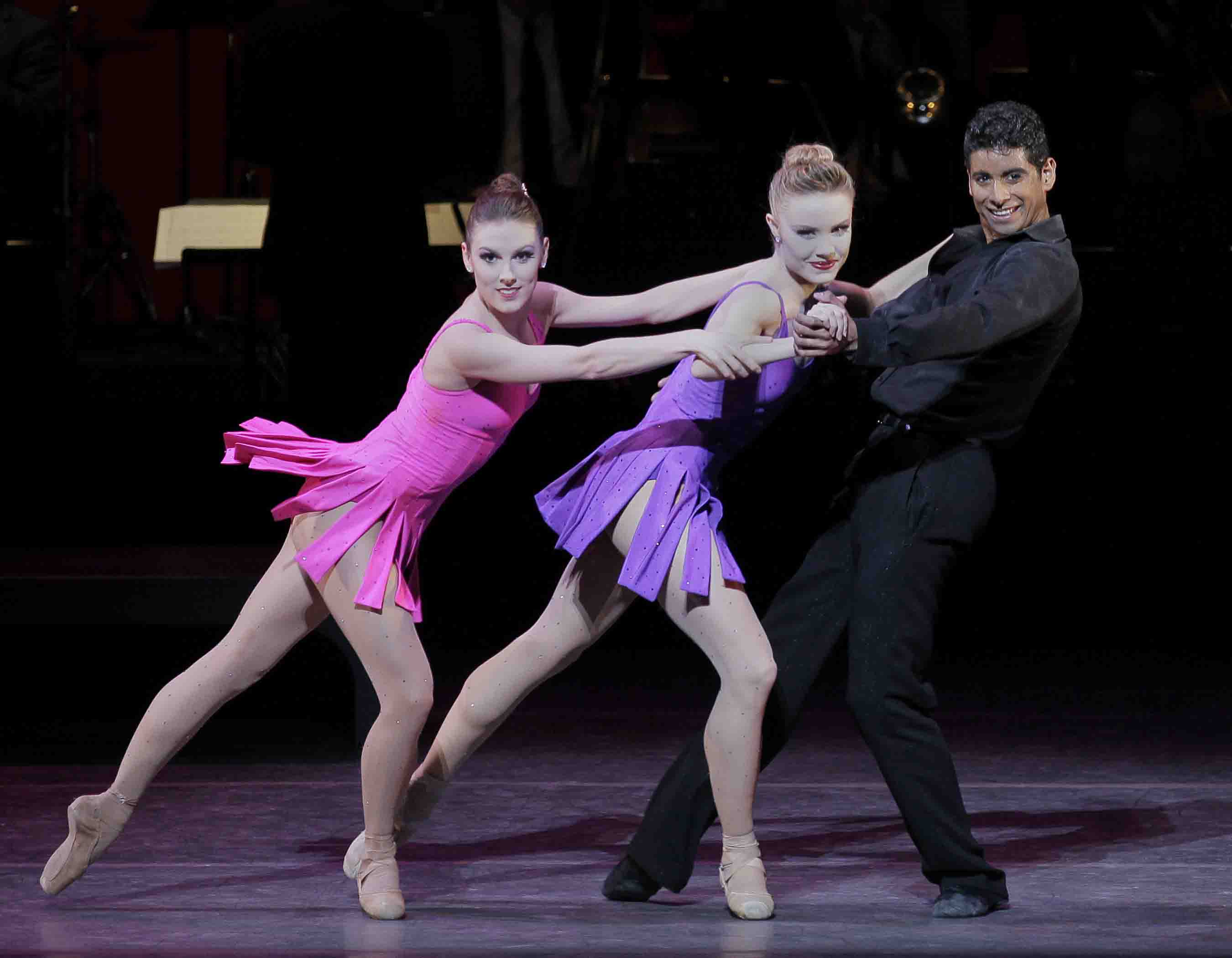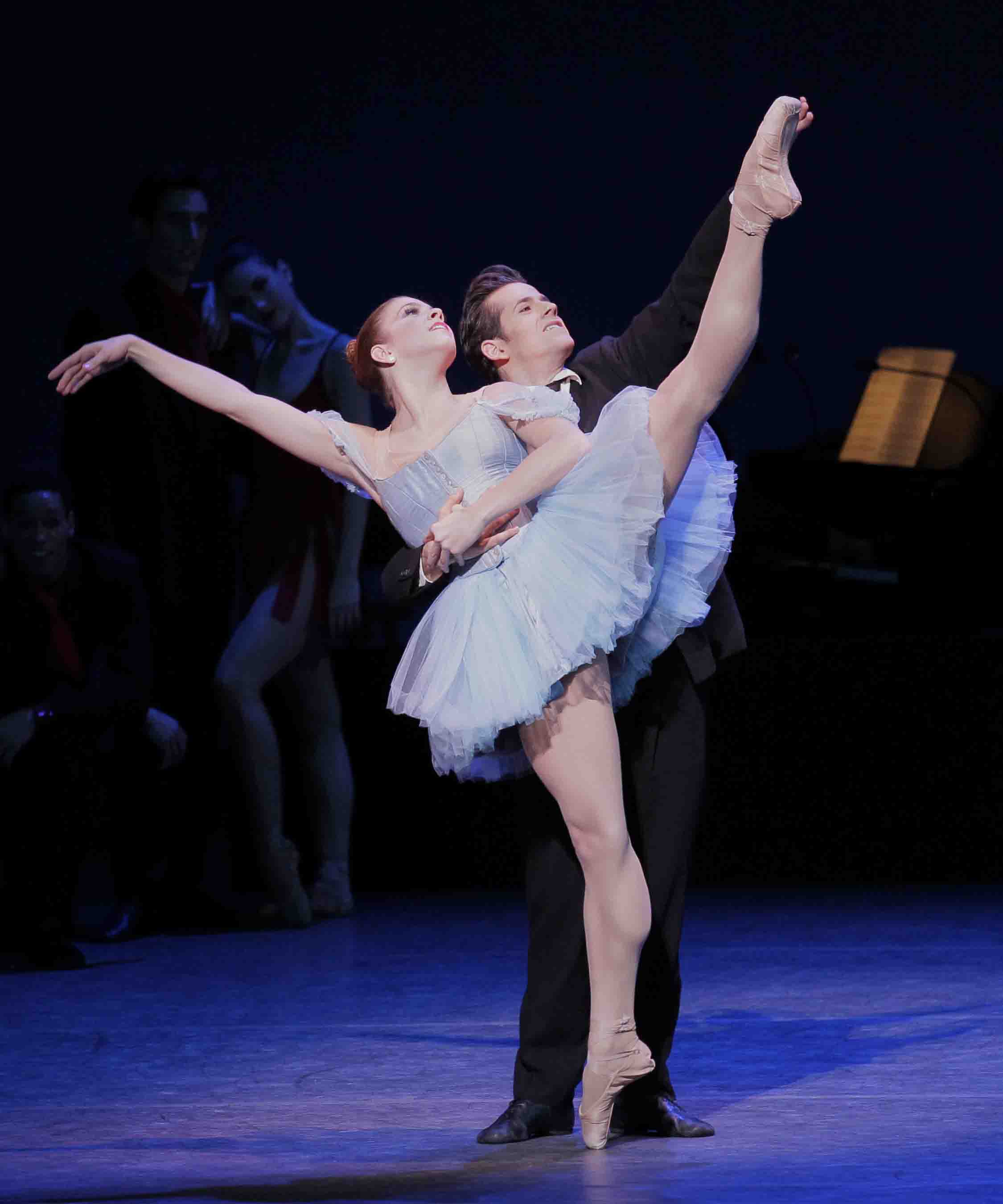Paul Taylor Dance Company / City Center, NYC / February 22 – March 6, 2011
Year after year, Paul Taylor can be counted on to create a pair of new dances–one light (such as the luminous Aureole, from 1962) and one dark (like the 1985 Last Look, which portrays the human race at the horrifying and undeniably convincing end of its rope).
The first of the pair of works new to New York shown in his company’s current engagement (February 22 – March 6, at City Center), sported the Edward Gorey-ish title Three Dubious Memories. Presumably this was the light one, though the opening night audience was understandably unsure if it was OK to laugh. For a long-time dance observer, the piece registered a fond if typically ironic survey by Taylor of his inheritance as both dancer and choreographer. Taylor being Taylor, Memories took a wry look at his own contribution to an ongoing tradition in which invention can morph into habit before you know it.
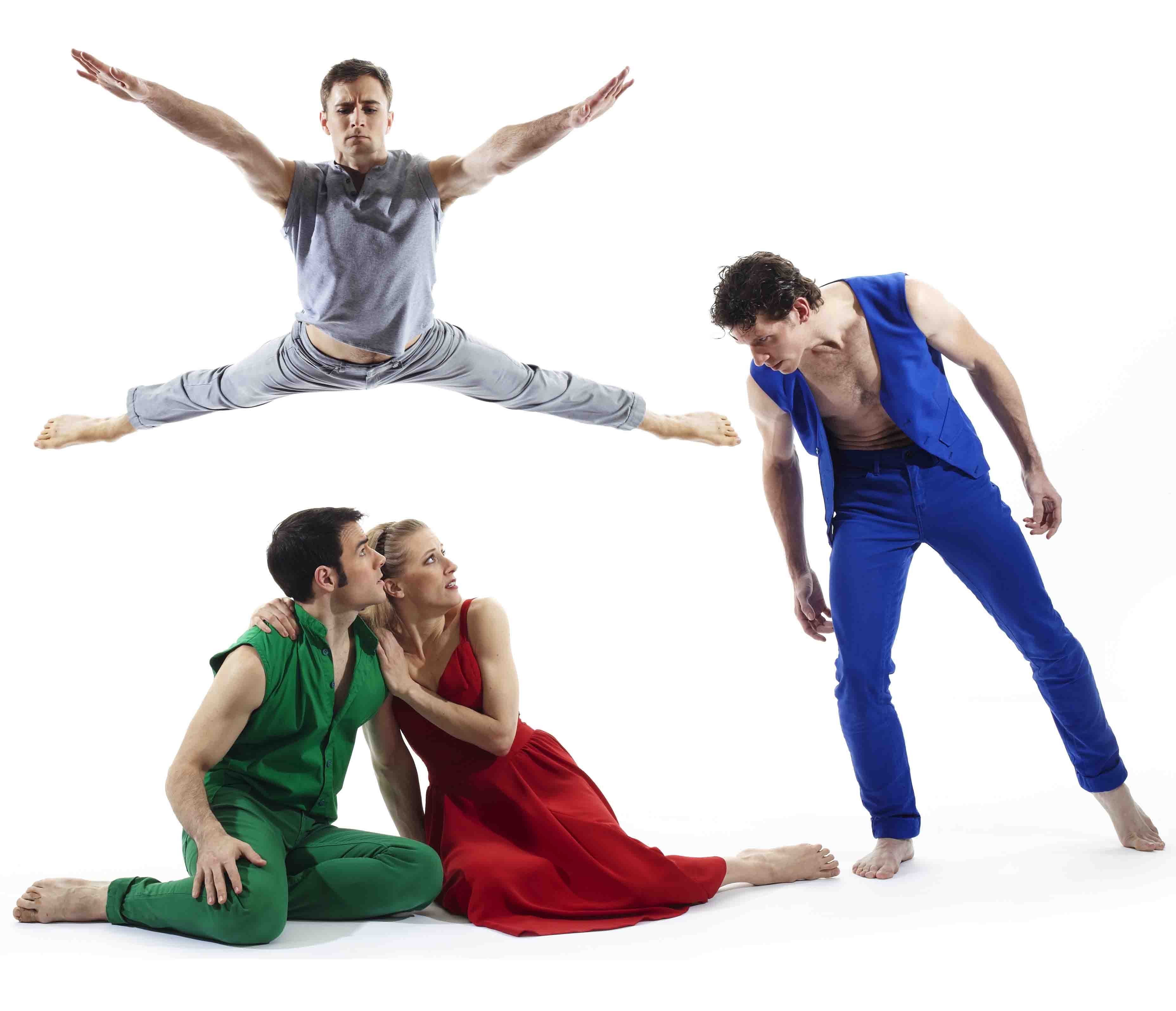
Meet the Stars: James Samson (airborne); (l. to r.) Robert Kleinendorst, Amy Young, and Sean Mahoney in Paul Taylor’s Three Dubious Memories
Photo: Tom Caravaglia
The list of characters (“The Woman in Red”), casting (“Messrs. Smith, Graciano, Apuzzo, Novak”), and sections of the dance (“As Remembered by the Man in Blue”) are a blatant spoof of Antony Tudor, the master choreographer of psychology and suggestion, with whom Taylor studied in his formative years. The actual proceedings (vivid drama with mythical implications) and the gut-sprung movement vocabulary concentrate on what he absorbed as a leading dancer with Martha Graham, diva and queen of the 20th century’s “Major Moderns.” Graham herself liked to say, “I only steal from the best,” but even as Taylor quotes, borrows, and steals from the lady, he never quite manages–here and in some previous works–to suspend his disbelief in her highly-colored aesthetic.
Set to Peter Elyakim Taussig’s Five Enigmas, Taylor’s trio of questionable recollections concerns two guys (one in blue and t’other in green) and that gal in red (Graham’s favorite color for flamboyance). The protagonists’ shifting interrelationships are played out like courtroom testimony as to what really went on among the three. Their conflicting Rashomon-like reports run the gamut from tender boy/girl love interrupted by various violent attacks to a he/he coupling that begins with buddy-like horsing around–to which Ms. Red naturally objects. But these color-coded personages are mere stick figures acting out banal, if melodramatic, scenarios–not unique temperaments seriously invested in their desires.
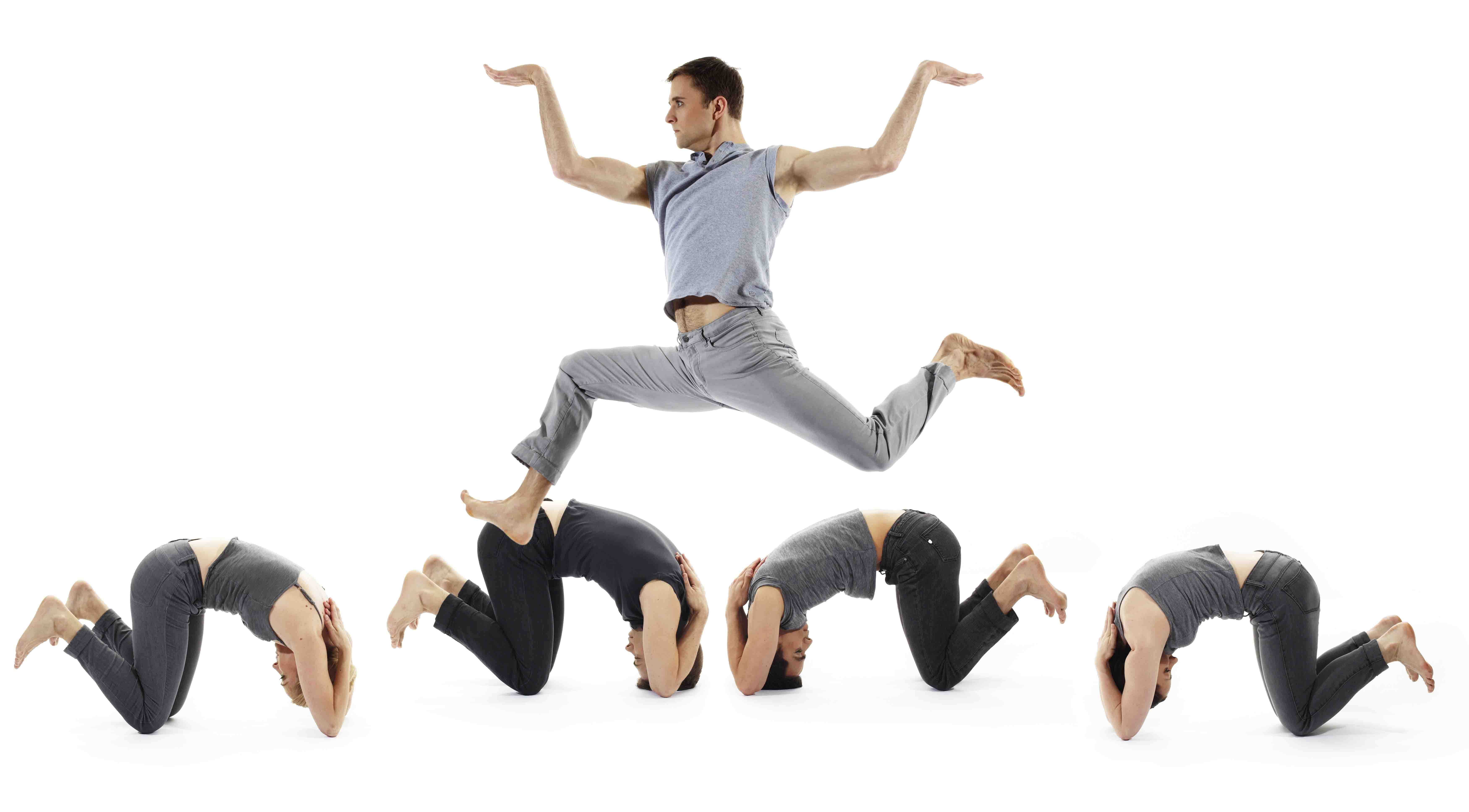
Haven’t We Done This Somewhere Before? James Samson as Choirmaster with some of his followers in Three Dubious Memories
Photo: Tom Caravaglia
The sole rich character in Three Dubious Memories is a collective one–The Choirmaster and his seven Choristers. They constitute the judge and jury who must hear the inconsistent testimony and decide where truth lies. I imagine that, in conversation, Taylor might well say “They’re all right,” and leave the question unsettled. Indeed, it’s there that he leaves the piece, perhaps having persuaded his most receptive viewers to realize that experience never has a definite truth but is strangely subjective.
The “choral” group refers back to Graham’s masterly choruses, especially to the small bevy of women and their Leader in Night Journey, which relates the tragedy of Oedipus and Jocasta, in her Greek cycle of dances. Taylor’s chorus, dressed in the simplest of practice clothes in shades of industrial gray, has what you might call all the best lines.

Hieroglyphic Frieze: Eran Bugge, Michael Novak, Francisco Graciano, and Jamie Rae Walker as Choristers in Three Dubious Memories
Photo: Tom Caravaglia
The Choirmaster moves in counterpoint to his seven subordinates, who typically work in unison, emphasizing the idea of many individuals’ becoming a singular force with singular power. Often they operate in the two-dimensional mode typical of ancient Egyptian art–head, legs, and feet presented in profile, chest seen full-frontal–a device that Taylor borrowed brilliantly for his 1980 Sacre du Printemps (The Rehearsal).
Sitting or squatting, they become self-contained statues of Asian gods. Supine, they flutter their hands in the air to create an army of butterflies. Upright, they extend an arm straight ahead of them, sharply angling the wrist so the hand flips upwards to form a shield that would halt anyone or anything in its tracks. Taylor lavishes a huge vocabulary on these figures; they seem to be the vehicle of his imagination.
The opening night program, which included the expendable Oh, You Kid!, began with one of the best performances of Taylor’s celebrated Esplanade I’ve ever witnessed. It looked as if it had been taken apart, scrupulously reconsidered, then polished to a high degree of freshness and–believe it or not–spontaneity. This dance, deliberately made without formal dance steps but instead with “pedestrian” elements like hell-bent running, ebullient jumps, slides, falls, and meditative walking (often cradling another body) is exhilarating in its sheer physicality.
The middle section, built from the subtlest of ordinary gestures–extending a hand or turning away, crawling in an ever-tightening huddle, like a herd of sheep sheltering from a storm–is devastating in the feelings it projects or, rather, suggests. Without identifying characters, providing a narrative, or succumbing to acting in its usual sense, this section conjures up thwarted family relationships and makes the weight of them almost unbearable.
The viewer is rescued from despair by the final section of the dance, which has the full cast skidding and plummeting to the ground in a dozen different ways and rising to fall again (and again) as it joyously challenges imaginary high winds. Esplanade could be an advertisement for “Life–despite everything.” The audience I was part of responded with near-hysterical enthusiasm.
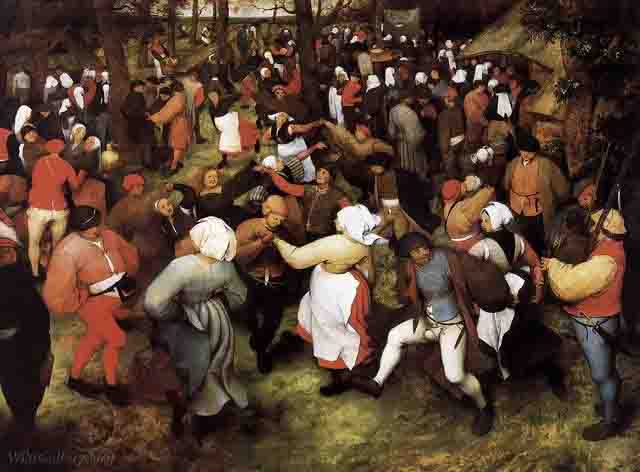
Pieter Brueghel the Elder, The Wedding Dance in the Open Air (1566)
Detroit Institute of Art
Photo source: WikiGallery
Part of Taylor’s inspiration for Phantasmagoria, the season’s second newish piece, came from a painting–Pieter Brueghel the Elder’s 1566 Wedding Dance in the Open Air, about which William Carlos Williams wrote:
Disciplined by the artist
to go round
& round
in holiday gear
a riotously gay rabble of
peasants and their
ample-bottomed doxies
fills
the market square . . .
Painter and poet describe a dance I think Taylor would enjoy watching–even, in his thoughts, being part of–but as a choreographer he can’t sustain a portrayal of it or come up with a contemporary equivalent. (Mark Morris is our man for that.) Only the opening tableau of Taylor’s dance fits Brueghel’s lusty image, and that largely thanks to Santo Loquasto’s costumes (faithful enough to replicate the men’s aroused privates).
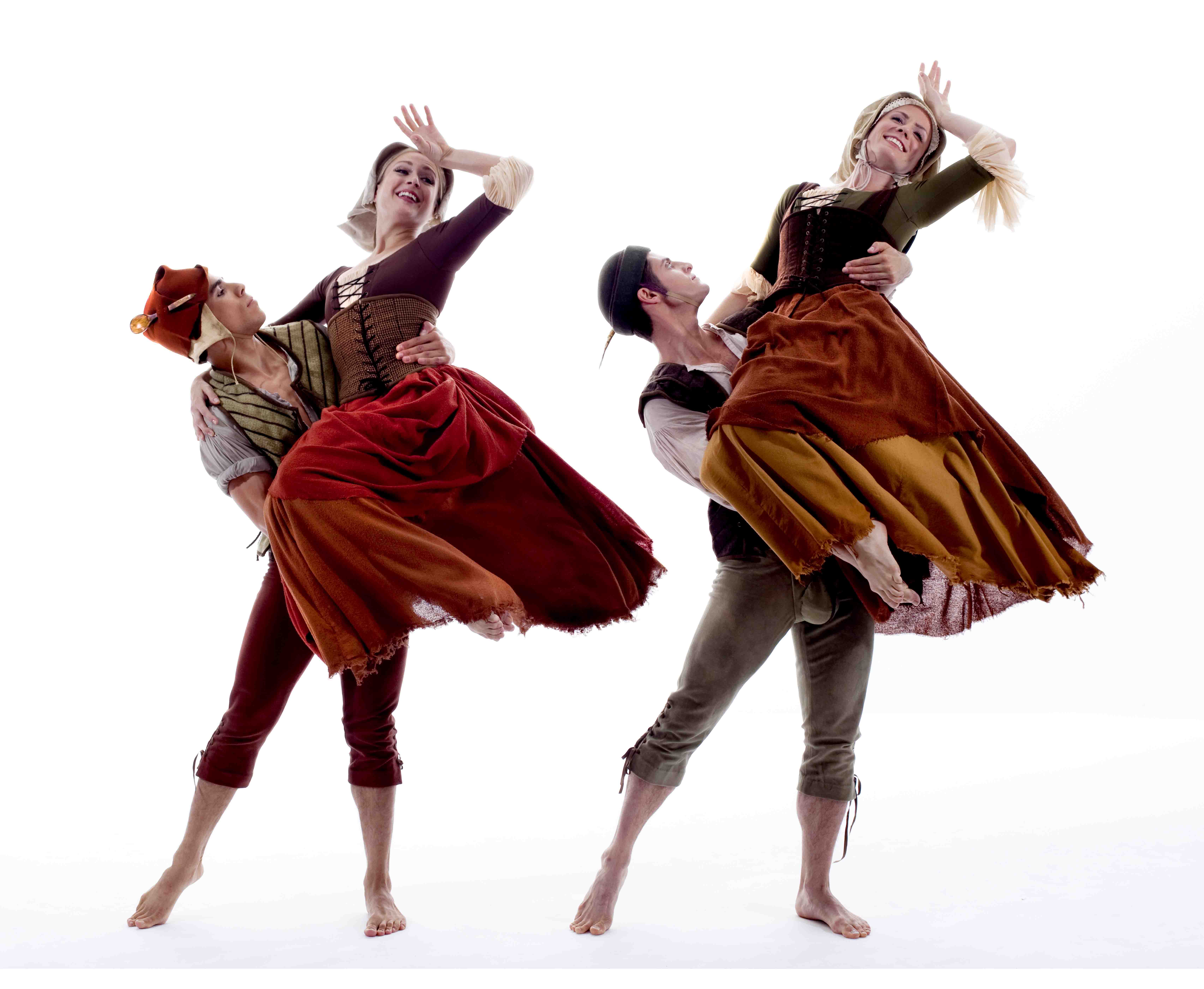
Flemish Frolics: (l.) Francisco Graciano and Jamie Rae Walker; (r.) Michael Apuzzo and Eran Bugge in Taylor’s Phantasmagoria
Photo: Tom Caravaglia
Taylor is quick to report the other side of human existence, showing the life-affirming Flemish crew plagued by difficulty, grief, and bitter rage. But then, for no apparent reason–and though the dance is set to a Taylor-made collage of Renaissance music–he moves on to a fast-forward slide show of unrelated scenes. First he offers us an “East Indian Adam and Eve” in glittering costumes making lascivious use of a sex toy in the shape of a long plush snake. A “Byzantine nun” with a high, pointed headdress shoos them off, only to dally with the reptile herself. Michelle Fleet, who is having her best season yet, appears to do a round of Irish step dancing, her arms hanging quietly by the sides of her motionless torso while her footgear, reinforced by taps, chatters on beneath her.
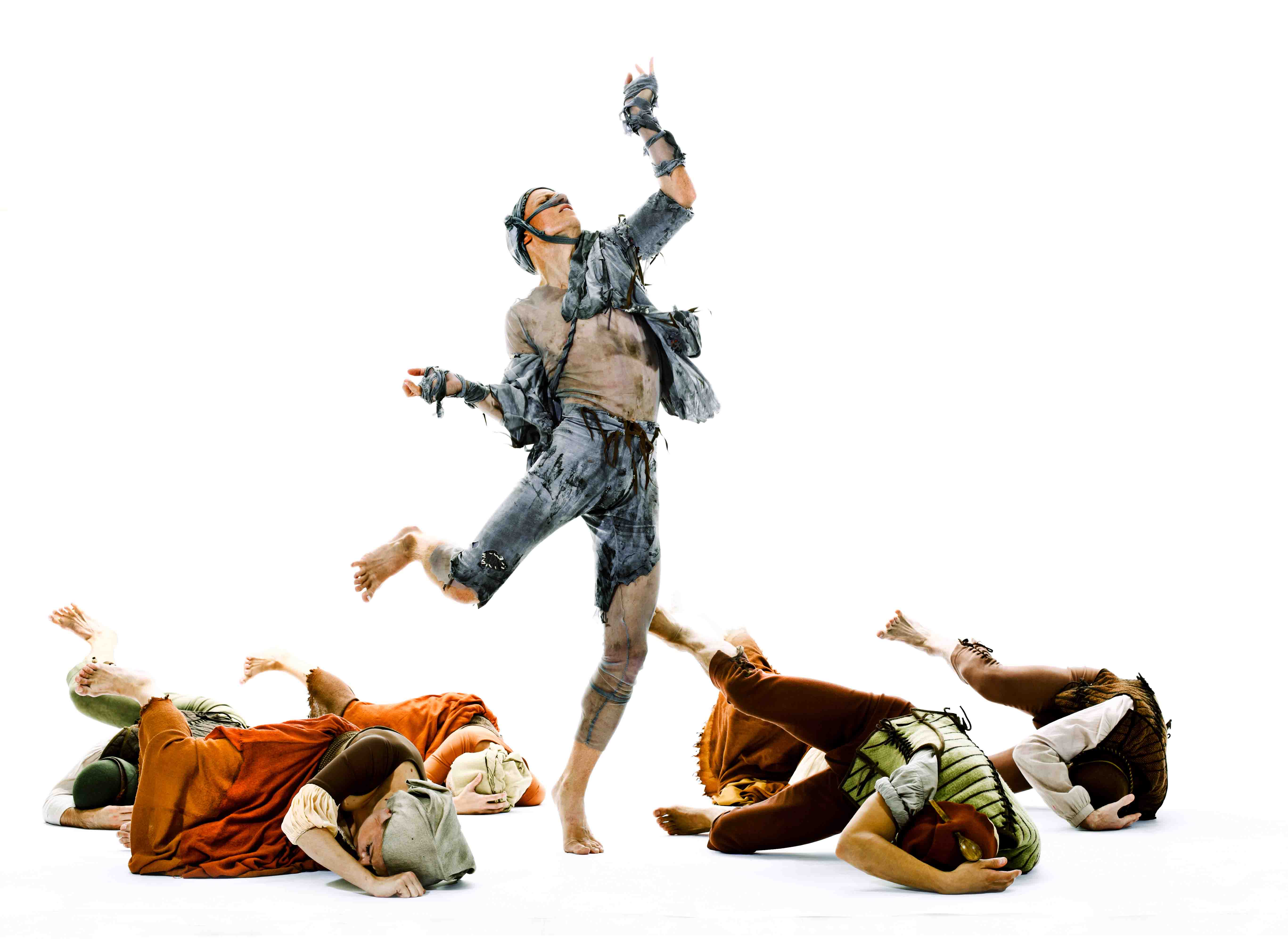
The Plague: Michael Trusnovic and members of the Paul Taylor Dance Company in Phantasmagoria
Photo: Tom Caravaglia
A quartet of unruly peasant fellows is replaced by a floaty, saccharine trio of Isadorables, who are in turn harassed by a “Bowery bum.” The wino, played by Robert Kleinendorst, paper-bagged bottle in hand, is appropriately besmirched and disheveled, with a lurching gait and a personality that’s somehow endearing. The final figure added to this improbable–and unconvincing–mix is a figure of death (Michael Trusnovec, usually assigned Apollonic roles), who transmits his disease, St. Vitus’s dance, to all and sundry. The full cast starts writhing itself out of this world, then resurrects for a cheerier finale.
So, as it turns out, Phantasmagoria is light–rather than the dark piece I’d assumed we were owed–and not merely light, in the sense of light-spirited but, alas, light-weight in intent and invention. Taylor has exercised his sense of humor here in its silly, immature guise, as if trying to see, as he does periodically, if he can get away with nonsense. That’s fine with me, on the boys-will-be-boys principle, as long as I don’t have to see the results a second time.
The dances that accompanied Phantasmagoria on its first night in town, however, rank among Taylor’s finest. Polaris and Cloven Kingdom, both created in 1976, surely a vintage year for the choreographer, were given vivid–indeed, riveting–performances.
All the dances I’ve mentioned were lighted by Jennifer Tipton, the most sensitive artist in her intangible domain.
© 2011 Tobi Tobias




